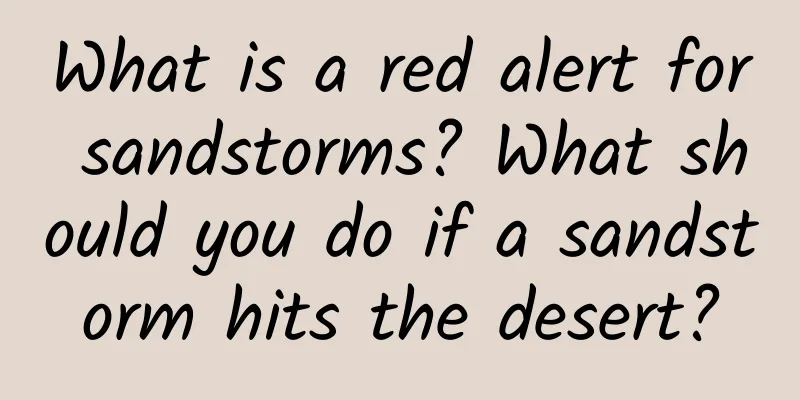What is a red alert for sandstorms? What should you do if a sandstorm hits the desert?

|
Dust storms are common meteorological disasters in arid and semi-arid areas. Their formation is affected by both natural factors and human activities. What is a red alert for sandstorms? What should we do when a sandstorm comes? What should we do in the face of a sandstorm? The following content will introduce it to you. Contents of this article 1. What is a sandstorm red alert? 2. What should I do if a sandstorm comes in the desert? 3. What should we do in the face of sandstorms? 1What is a sandstorm red alert?The red warning signal for sandstorms is a warning signal issued by the meteorological department through meteorological monitoring before the arrival of a sandstorm, reminding people to avoid sandstorms and agriculture to minimize the losses caused by sandstorms. The red warning signal for sandstorms is the third level of sandstorm warning signals. Dust storms are severe and disastrous weather that occurs in northwest China and northern North China. They can cause house collapse, obstruction or interruption of transportation and power supply, fire, casualties of people and animals, pollute the natural environment, destroy crop growth, and cause serious losses and great harm to the national economic construction and the safety of people's lives and property. When a sandstorm occurs, the sand and dust carried by the strong wind spread everywhere, and the air in the area passed by became turbid, choking the nose and eyes, and the number of people suffering from respiratory diseases increased. For example, on May 5, 1993, a strong sandstorm occurred in Jinchang City. The dust content in the outdoor air monitored was 1016 mm/cubic centimeter, and the indoor air was 80 mm/cubic centimeter, which was 40 times higher than the national standard for dust content in living areas. 2What should I do if a sandstorm comes in the desert?Lie down first and use the windproof glasses, hat, mask, and scarf you carry with you to protect your body to reduce the damage of the sandstorm to the respiratory tract, eyes, etc. Observe the surrounding environment, find a low slope or stone that can be sheltered from the wind, and crawl closer. Follow the principle of life first and property second and wait for rescue. Dust storms are common meteorological hazards in arid and semi-arid regions. They are usually triggered by thunderstorms or strong pressure gradients associated with cyclones, which increase wind speeds over a wide area. These strong winds can lift large amounts of sand and dust from exposed dry soil into the atmosphere and transport them hundreds to thousands of kilometers away. About 40% of aerosols in the troposphere (the lowest layer of the Earth's atmosphere) are dust particles caused by wind erosion. Once dust particles leave the ground, they are carried to higher levels of the troposphere by turbulent mixing and convective updrafts. They are then transported by winds, for a period of time that depends on the size of the particles and meteorological conditions, and fall back to the surface. As larger particles fall faster than smaller particles, they become smaller as they are transported. Precipitation also washes dust out of the atmosphere. 3What should we do in the face of sandstorms?In the face of sandstorms, we should try to reduce going out, and wear masks and goggles when going out to prevent the dust from harming the respiratory tract and eyes. When riding or driving, we should slow down and stay away from trees and billboards to avoid being hit. At home, we should try to avoid opening windows frequently, and we can also use tape to stick on the glass in a cross shape to prevent glass from breaking and injuring people. In terms of diet, we should drink more water and eat more light food. A sandstorm is a weather phenomenon in which strong winds blow up dust from the ground, making the air very turbid and the horizontal visibility less than 1 km. Sandstorms are a weather phenomenon in wind erosion and desertification, and their formation is affected by both natural factors and human activities. Natural factors include strong winds, reduced precipitation and sand sources. Human activities refer to the increased frequency of sandstorms caused by the destruction of vegetation by humans in the process of economic development. Sandstorms mainly occur in winter and spring. This is because there is very little precipitation in semi-arid and arid areas in winter and spring, the ground surface is extremely dry and loose, and its ability to resist wind erosion is very weak. When strong winds blow, a large amount of sand and dust will be blown into the air, forming sandstorms. |
<<: What is a sandstorm? What are the hazards of sandstorms?
>>: A 27-year-old boy forgets words when he picks up a pen. Do you have this problem?
Recommend
Foods to treat uterine cold
Women may experience abdominal pain during menstr...
Can pregnant women eat rhubarb?
Rhubarb is a medicinal herb, not the rhubarb vege...
Can you hear the fetal heartbeat at 10 weeks?
When a pregnant woman is more than six weeks preg...
What are the main reasons for thick and yellow leucorrhea?
Leucorrhea is a physiological tissue unique to wo...
Why do I fart down there?
The structure of the human body is very magical, ...
Can we see Mars from Earth? What does the mysterious veil of Mars mean?
People don't know much about Mars and have ne...
Breast epithelial hyperplasia
Women must pay attention to their breast health a...
80% of people don’t know the functions and effects of protein powder
Protein powder is a nutrient that many people con...
What is pelvic inflammatory disease?
For women, gynecological diseases are very troubl...
Is there any scientific reason behind the saying “Drinking water in big gulps is the same as not drinking it at all”?
Have you ever heard of the view that "drinki...
The cat's neck was bitten and turned into ringworm. What's going on? Cats have ringworm. How to deal with it?
Ringworm is not a serious disease, but it takes t...
38 days of pregnancy, low progesterone, hcg doubled
As we all know, progesterone is a kind of estroge...
What are the symptoms of precocious puberty in girls
The phenomenon of precocious puberty is very comm...
Causes and suggestions for chest pain during pregnancy
Expectant mothers may not be able to adapt to the...









